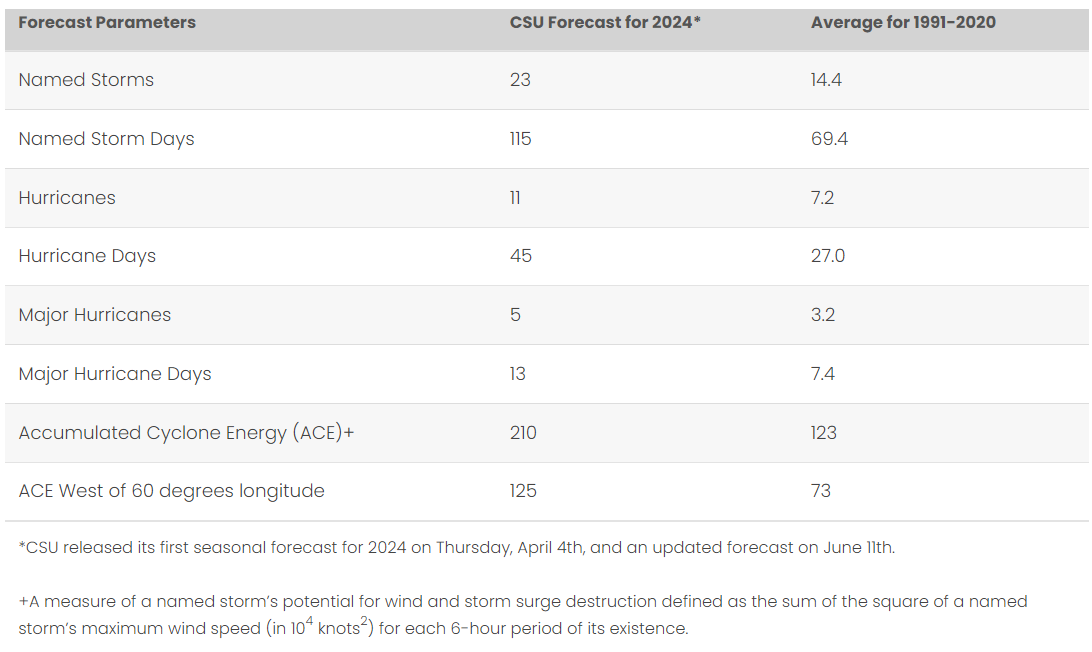Scientists keep banging their heads against the wall, perhaps even harder these days, as the environmental red flags across the globe pile up. It is not as if we haven’t already seen actual results, the power of storms, heat waves (can you call the smashing of heat records everyday a ‘wave’ anymore?), and wildfires have broken records repeatedly for at least the last decade, but especially over the last two years. From April of 2023 to April 24, 2024, for example, the ocean broke its previous record for highest water temperature ever recorded, Every. Single. Day. What is more frightening is that those records it broke were themselves broken records from 2022 to 2023.
High ocean heat is a bellwether for other calamities. In particular, hurricanes, because those storms gather strength from water vapor and surface heat of the waters. Colorado State University projected that 2024 would see much higher numbers of storms significant enough to earn a name in comparison with historical averages.
Hurricane Beryl, the opening act for this season, is the first ever to become a Category 4 this early in the year. Then, it became a Category 5 a few days later, breaking that record too. Then, as if that was not enough, it became the strongest recorded hurricane ever in the month of July. And Beryl isn’t finished. Even now, though it reduced to a Tropical Storm as it made its first pass over land where these storms weaken for lack of water, it is resuming its path across the Gulf of Mexico where forecasters expect it will regain hurricane strength. Much of the east coast of Texas awaits its landfall, predicted around the morning of July 8.
Alaska earned its own environmental Razzie award just a week or so ago when scientists published a paper boringly titled, “Accelerating glacier volume loss on Juneau Icefield driven by hypsometry and melt-accelerating feedbacks.” Don’t let the jargon fool you. What they uncovered is devastating. They measured the Juneau Icefield, a glacial mass covering 1,500 square miles (3,885 sq. km.), and here is what they found:
Its snow-covered area is shrinking 4.6 times faster than it was prior to the 1980s, [the] researchers say—and between 2010 and 2020, it lost roughly 1.4 cubic miles of ice per year. Now, meltwater is flowing from the icefield at 50,000 gallons per second, reports Seth Borenstein of the Associated Press (AP).
In a study measuring the contributors to rising global sea level, researchers determined that from 1961 to 2016, melting Alaskan ice “accounts for 25 to 30 per cent of the total observed sea-level rise.” As the study cited above notes, the rate of melt in Alaska over just the past decade is accelerating more rapidly than ever. Bethan Davies, a glaciologist in the U.K.'s Newcastle University, who co-authored it told USA Today:
This work has shown that different processes can accelerate melt, which means that current glacier projections may be too small and underestimate glacier melt in the future.
Beefier hurricanes and melting glaciers have a profound effect on shorelines. The US Geological Survey explains:
Beach erosion occurs when waves and currents remove sand from the beach system. The loss of sand causes the beach to become narrower and lower in elevation. Storm waves carry the sand offshore, depositing and storing the sediment in large sandbars. In weeks and months following the storm, the sand is returned to the beach by calm-weather waves. Because many states rely on beach-related tourism as a major source of revenue, beach erosion has become a serious concern for coastal counties throughout the United States. Beach erosion also threatens coastal properties and infrastructure, such as roads, homes, and businesses. A series of storms can cause significant retreat of the shoreline, leaving coastal property more vulnerable to future storms.
A study by Mohammad Jamous, Reza Marsooli, and Jon K. Miller analyzed the trajectory of erosion on shores hit by increasingly powerful storms. Using shoreline damage data caused by previous storms, they developed a model based on projected storms to estimate the impact on coasts affected by the Atlantic hurricane system. They concluded:
[W]e find a substantial increase in erosion hazards from the late-20th-century to late-21st-century. The regionally averaged 100-year eroded volume of beach-dune systems would increase by 58 and 84%. [The variations depend upon the composition of the shore itself].
As sea levels rise from precipitous ice melt across the globe, and historic storms rip away more and more shoreline earthen infrastructure, one thing is clear:
I hope you don’t like beaches.
***
To learn how the United States Supreme Court might have just destroyed that country’s efforts to mitigate climate change, click below.
***
I am a Certified Forensic Computer Examiner, Certified Crime Analyst, Certified Fraud Examiner, and Certified Financial Crimes Investigator with a Juris Doctor and a Master’s degree in history. I spent 10 years working in the New York State Division of Criminal Justice as Senior Analyst and Investigator. I was a firefighter before I joined law enforcement.
Visit the new Evidence Files Law and Politics Deep Dive on Medium, or check out the Evidence Files Facebook; Like, Follow, Subscribe or Share!
Find more about me on Instagram, Facebook, LinkedIn, or Mastodon. Or visit my EALS Global Foundation’s webpage page here. If you enjoy my work, consider becoming a paid subscriber. Thanks!






Scary and nothing to swoop in and save the planet from all of this .. no country is doing the right thing to make things right, but people trying to get rich on devices and ideas and none are working..
A fast asteroid taking out everything and everybody would be better than the slow death from our own doings even if it is natural we all know that we have continuously destroyed everything and ideas are hidden or shelved.